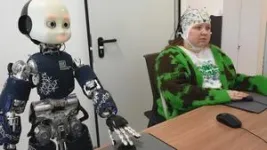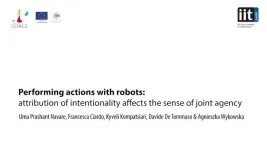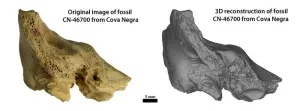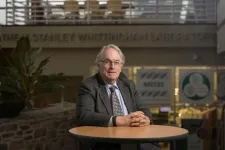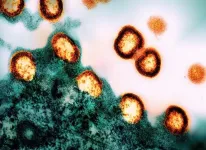(Press-News.org) North Carolina State University researchers have developed a kirigami-inspired mechanical computer that uses a complex structure of rigid, interconnected polymer cubes to store, retrieve and erase data without relying on electronic components. The system also includes a reversible feature that allows users to control when data editing is permitted and when data should be locked in place.
Mechanical computers are computers that operate using mechanical components rather than electronic ones. Historically, these mechanical components have been things like levers or gears. However, mechanical computers can also be made using structures that are multistable, meaning they have more than one stable state – think of anything that can be folded into more than one stable position.
“We were interested in doing a couple things here,” says Jie Yin, co-corresponding author of a paper on the work and an associate professor of mechanical and aerospace engineering at NC State. “First, we were interested in developing a stable, mechanical system for storing data.
“Second, this proof-of-concept work focused on binary computing functions with a cube being either pushed up or pushed down – it’s either a 1 or a 0. But we think there is potential here for more complex computing, with data being conveyed by how high a given cube has been pushed up. We’ve shown within this proof-of-concept system that cubes can have five or more different states. Theoretically, that means a given cube can convey not only a 1 or a 0, but also a 2, 3 or 4.”
The fundamental units of the new mechanical computer are 1-centimeter plastic cubes, grouped into functional units consisting of 64 interconnected cubes. The design of these units was inspired by kirigami, which is the art of cutting and folding paper. Yin and his collaborators have applied the principles of kirigami to three-dimensional materials that are cut into connected cubes.
When any of the cubes are pushed up or down, this changes the geometry – or architecture – of all of the connected cubes. This can be done by physically pushing up or down on one of the cubes, or by attaching a magnetic plate to the top of the functional unit and applying a magnetic field to remotely push it up or down. These 64-cube functional units can be grouped together into increasingly complex metastructures that allow for storing more data or for conducting more complex computations.
The cubes are connected by thin strips of elastic tape. To edit data, you have to change the configuration of functional units. That requires users to pull on the edges of the metastructure, which stretches the elastic tape and allows you to push cubes up or down. When you release the metastructure, the tape contracts, locking the cubes – and the data – in place.
“One potential application for this is that it allows for users to create three-dimensional, mechanical encryption or decryption,” says Yanbin Li, first author of the paper and a postdoctoral researcher at NC State. “For example, a specific configuration of functional units could serve as a 3D password.
“And the information density is quite good,” Li says. “Using a binary framework – where cubes are either up or down – a simple metastructure of 9 functional units has more than 362,000 possible configurations.”
“But we’re not necessarily limited to a binary context,” says Yin. “Each functional unit of 64 cubes can be configured into a wide variety of architectures, with cubes stacked up to five cubes high. This allows for the development of computing that goes well beyond binary code. Our proof-of-concept work here demonstrates the potential range of these architectures, but we have not developed code that capitalizes on those architectures. We’d be interested in collaborating with other researchers to explore the coding potential of these metastructures.”
“We’re also interested in exploring the potential utility of these metastructures to create haptic systems that display information in a three-dimensional context, rather than as pixels on a screen,” says Li.
The paper, “Reprogrammable and Reconfigurable Mechanical Computing Metastructures with Stable and High-Density Memory” is published in the open-access journal Science Advances. Co-corresponding author of the paper is Hao Su, an associate professor of mechanical and aerospace engineering at NC State. The paper was co-authored by Shuangye Yu and Yaoye Hong, former Ph.D. students at NC State; Haitao Qing and Fangjie Qi, current Ph.D. students at NC State; and Yao Zhao, a former postdoctoral researcher at NC State.
The work was done with support from the National Science Foundation under grants 2005374, 2126072 and 2231419.
END
Mechanical computer relies on kirigami cubes, not electronics
2024-06-26
ELSE PRESS RELEASES FROM THIS DATE:
Acting for a common goal with humanoid robots
2024-06-26
Genova (Italy), 26 June 2024 – Researchers at the Istituto Italiano di Tecnologia (IIT-Italian Institute of Technology) have demonstrated that under specific conditions, humans can treat robots as co-authors of the results of their actions. The condition that enables this phenomenon is that a robot behaves in a human-like, social manner. Engaging in gaze contact and participating in a common emotional experience, such as watching a movie, are the key. The study was published in Science Robotics and paves the way for understanding and designing the optimal circumstances for humans and robots to collaborate in the same environment.
The ...
Time-compression in electron microscopy
2024-06-26
Scientists at the University of Konstanz in Germany have advanced ultrafast electron microscopy to unprecedented time resolution. Reporting in Science Advances, the research team presents a method for the all-optical control, compression, and characterization of electron pulses within a transmission electron microscope using terahertz light. Additionally, the researchers have discovered substantial anti-correlations in the time domain for two-electron and three-electron states, providing deeper insight into the quantum physics of ...
First case of Down syndrome in Neandertals documented in new study
2024-06-26
BINGHAMTON, N.Y. -- A new study published by an international multidisciplinary team of researchers including faculty at Binghamton University, State University of New York, documents the first case of Down syndrome in Neandertals and reveals that they were capable of providing altruistic care and support for a vulnerable member of their social group.
The research, led by anthropologists at the University of Alcalá and the University of Valencia in Spain, studied the skeletal remains of a Neandertal child, whom they affectionately named “Tina”, found at Cova Negra, a cave in Valencia, Spain long known for yielding important Neandertal discoveries.
“The ...
Future risk of coral bleaching set to intensify globally
2024-06-26
An international team of researchers led by the University of Adelaide has projected future marine heatwaves will cause coral reefs to be at severe risk of bleaching for longer periods than previously seen.
Through climate modelling and supercomputing, the researchers discovered that extended bleaching events may significantly disrupt coral spawning.
“We found that coral bleaching will start earlier in the year and last longer than previously thought,” said lead author Dr Camille Mellin, from the University of Adelaide’s Environment Institute.
“Our results show that by 2080, coral bleaching will tend to start in spring, rather than late summer, which ...
The science of procrastination
2024-06-26
Procrastination, the deliberate but detrimental deferring of tasks, has many forms. Sahiti Chebolu of the Max Planck Institute for Biological Cybernetics uses a precise mathematical framework to understand its different patterns and their underlying reasons. Her insights could help tailor individual strategies to tackle the issue.
“Why did I not do this when I still had the time?” – Whether it is filing taxes, meeting a deadline at work, or cleaning the apartment before a family visit, most of us have already wondered why we tend to put off certain tasks, even in the face of unpleasant consequences. Why do we make decisions that are harmful to us – against our better ...
Saudi women’s quest for change enabled them earn citizenship rights
2024-06-26
Saudi women have obtained their citizenship rights through their own struggle and there is little truth in the widely held idea in the West that their role in the fight for their freedom has been negligible.
The finding is part of a new research in the journal Diogenes authored by Zahia Salhi, a professor at Sharjah University’s College of Arts, Humanities, and Social Sciences. The University of Cambridge Press has also posted Prof. Salhi’s research online.
“Far from being passive victims of their society, Saudi women are active agents ...
Introducing Sir Stanley: Binghamton University professor and Nobel Prize winner knighted by King Charles
2024-06-26
BINGHAMTON, N.Y. -- Binghamton University, State University of New York Distinguished Professor and Nobel Prize Laureate M. Stanley Whittingham has been named a Knight Bachelor “for his services to research in chemistry.”
The honor entitles him to be known as Sir Stanley, or Sir Stanley Whittingham, and was announced as part of King Charles III’s official birthday honours list.
In his 30-plus-year career, Whittingham has been a pioneer in the development of lithium-ion batteries, for which he won the Nobel Prize in Chemistry in 2019. ...
NIH statement on preliminary efficacy results of twice-yearly lenacapavir for HIV prevention in cisgender women
2024-06-26
The injectable antiretroviral drug lenacapavir was safe and 100% effective as long-acting HIV pre-exposure prophylaxis (PrEP) among cisgender women in a Phase 3 clinical trial, according to top-line findings released by Gilead Sciences, Inc., the study sponsor. Lenacapavir is administered every six months, making it the most durable HIV prevention method to have shown efficacy in this population. NIAID applauds the study sponsor, investigators, study staff, and—most importantly—the participants ...
Neurobiologist Joshua C. Brumberg named CUNY Graduate Center president
2024-06-26
The City University of New York has appointed Joshua C. Brumberg as president of the CUNY Graduate Center, making permanent a post he has held on an interim basis since October 2023. Brumberg, a neurobiologist who has been a faculty member, dean and researcher during his 22-year career at CUNY, will lead the University’s renowned center of graduate education, scholarship and public-interest research. CUNY’s Board of Trustees approved the appointment at its meeting last night.
“Dr. Brumberg has played a key role in expanding CUNY’s research enterprise over the past several years,” said Chancellor Félix V. Matos Rodríguez. “A ...
Cell division: Before commitment, a very long engagement
2024-06-26
Before a cell commits fully to the process of dividing itself into two new cells, it may ensure the appropriateness of its commitment by staying for many hours—sometimes more than a day—in a reversible intermediate state, according to a discovery by researchers at Weill Cornell Medicine. Their revelation of this fundamental feature of biology includes details of its mechanisms and dynamics, which may inform the development of future therapies targeting cancers and other diseases.
In their study, published June 26 in Nature, the researchers developed new tools allowing them to track over time the activation state of E2F, a ...

